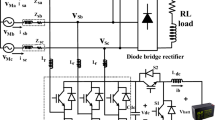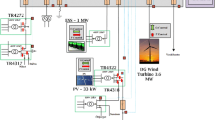Abstract
The idea of achieving zero-carbon emissions in the transportation sector through microgrid-based charging increases green electrification, fostering sustainable development with renewable energy sources (RES). Integrating solar photovoltaic (SPV) systems into residential grids presents challenges such as unpredictable solar power generation, electric vehicle (EV) charging fluctuations, and grid synchronization issues during faults. The current solutions face problems like irregular current patterns during high EV demand, inefficient charge/discharge management, and difficulty transitioning between modes, particularly with nonlinear loads. The proposed system offers the integration of an advanced energy management scheme (EMS) to optimize solar energy utilization and enhance grid stability. A unique model of Scott transformer connection-based dual active bridge (STC-DAB) converter topology is incorporated for bidirectional power flow from the battery energy storage (BES) system. The system also features innovative grid synchronization technology during abnormal grid conditions. An adaptive EMS ensures a stable power supply to EV and emergency loads, enhancing adaptability in grid tied mode (GTM) and stand-alone mode (SAM), even in fluctuating irradiation conditions. The proposed system surpasses traditional approaches by providing enhanced reliability through continuous power supply to BES and residential loads, ensuring stability even in challenging conditions. The system offers a reliable and sustainable power management solution.
















Similar content being viewed by others
Availability of data and materials
The authors can provide the data on request.
References
Allen MR, Dube OP, Solecki W, Aragon-Durand F, Cramer W, Humphreys S, Kainuma M, Kala J, Mahowald N, Mulugetta Y et al (2018) Framing and context. In: Global warming of 1.5 °C, an IPCC special report on the impacts of global warming of 1.5 °C above pre-industrial levels and related Global Greenhouse Gas Emission pathways, in the context of strengthening the global response to the threat of climate change, sustainable development, and efforts to eradicate poverty. IPCC, Paris, France.
Alahmadi A et al (2021) Hybrid wind/PV/battery energy management-based intelligent non-integer control for smart DC-microgrid of Smart University. IEEE Access 9:98948–98961. https://doi.org/10.1109/ACCESS.2021.3095973
Shah P, Hussain I, Singh B, Chandra A, Al-Haddad K (2019) GI-based control scheme for single-stage grid interfaced SECS for power quality improvement. IEEE Trans Ind Appl 55(1):869–881
Jain C, Singh B (2017) An adjustable DC link voltage-based control of multifunctional grid interfaced solar PV system. IEEE J Emerg Selected Topics Power Electron 5(2):651–660. https://doi.org/10.1109/JESTPE.2016.2627533
Bhattacharyya S, Kumar D, Samanta S, Mishra S (2021) Steady output and fast tracking MPPT (SOFT-MPPT) for P&O and InC algorithms. IEEE Trans Sustain Energy 12(1):293–302. https://doi.org/10.1109/TSTE.2020.2991768
Mahmoud Y, El-Saadany EF (2016) Fast power-peaks estimator for partially shaded PV systems. IEEE Trans Energy Convers 31(1):206–217. https://doi.org/10.1109/TEC.2015.2464334
Srivastava K, Kumar S, Maurya R (2023) A robust BCNMCC based variance smoothing approach for SPV based grid integrated EV battery charging system. J Energy Storage 72:108361
Zhang Y, You P, Cai L (2019) Optimal charging scheduling by pricing for EV charging station with dual charging modes. IEEE Trans Intell Transp Syst 20(9):3386–3396. https://doi.org/10.1109/TITS.2018.2876287
Feng S, Magee C (2020) Technological development of key domains in electric vehicles: Improvement rates, technology trajectories and key assignees. Appl Energy 260:114264
Verma A, Singh B, Chandra A, Al-Haddad K (2018) An implementation of solar PV array based multifunctional EV charger. In: IEEE Transportation Electrification Conference and Expo (ITEC), 2018, pp. 531–536. https://doi.org/10.1109/ITEC.2018.8450191.
Kikusato H et al (2019) Electric vehicle charge-discharge management for utilization of photovoltaic by coordination between home and grid energy management systems. IEEE Trans Smart Grid 10(3):3186–3197
Wang S et al (2021) Multifunction capability of SiC bidirectional portable chargers for electric vehicles. IEEE J Emerg Selected Topics Power Electron 9(5):6184–6195. https://doi.org/10.1109/JESTPE.2021.3052841
Hsu Y, Kao S, Ho C, Jhou P, Lu M, Liaw C (2018) On an electric scooter with G2V/V2H/V2G and energy harvesting functions. IEEE Trans Power Electron 33(8):6910–6925. https://doi.org/10.1109/TPEL.2017.2758642
Liu N, Chen Q, Lu X, Liu J, Zhang J (2015) A charging strategy for PV-based battery switch stations considering service availability and self-consumption of PV energy. IEEE Trans Ind Electron 62(8):4878–4889
Alam M, Muttaqi K, Sutanto D (2016) Effective utilization of available PEV battery capacity for mitigation of solar PV impact and grid support with integrated V2G functionality. IEEE Trans Smart Grid 7(3):1562–1571
Cao Y et al (2017) A cost-efficient communication framework for battery-switch-based electric vehicle charging. IEEE Commun Mag 55(5):162–169. https://doi.org/10.1109/MCOM.2017.1600913
Hackl C, Landerer M (2020) Modified second-order generalized integrators with modified frequency locked loop for fast harmonics estimation of distorted single-phase signals. IEEE Trans Power Electron 35(3):3298–3309
Hui N, Wang D, Li Y (2018) A novel hybrid filter-based PLL to eliminate effect of input harmonics and DC offset. IEEE Access 6:19762–19773. https://doi.org/10.1109/ACCESS.2018.2821704
Zhang C, Føyen S, Suul JA, Molinas M (2021) Modeling and analysis of SOGI-PLL/FLL-based synchronization units: stability impacts of different frequency-feedback paths. IEEE Trans Energy Convers 36(3):2047–2058. https://doi.org/10.1109/TEC.2020.3041797
Singh J, Behera R (2018) Hysteresis current controllers for grid connected inverter: review and experimental implementation. In: IEEE Intern. Confer. Power Electron. Drives and Energy Systems (PEDES), pp 1–6
Luo S, Wu F (2018) Hybrid modulation strategy for IGBT-based isolated dual-active-bridge DC–DC converter. IEEE J Emerg Selected Topics Power Electron 6(3):1336–1344
van Hoek H, Neubert M, Doncker R (2013) Enhanced modulation strategy for a three-phase dual active bridge—boosting efficiency of an electric vehicle converter. IEEE Trans Power Electron 28(12):5499–5507
Wen H, Li J, Shi H, Hu Y, Yang Y (2021) Fault diagnosis and tolerant control of dual-active-bridge converter with triple-phase shift control for bidirectional EV charging systems. IEEE Trans Transport Electrification 7(1):287–303
Zhao B, Song Q, Liu W, Sun Y (2014) Overview of dual-active-bridge isolated bidirectional DC–DC converter for high-frequency-link power-conversion system. IEEE Trans Power Electron 29(8):4091–4106. https://doi.org/10.1109/TPEL.2013.2289913
Huang J, Li Z, Shi L, Wang Y, Zhu J (2019) Optimized modulation and dynamic control of a three-phase dual active bridge converter with variable duty cycles. IEEE Trans Power Electron 34(3):2856–2873
Gupta J, Maurya R, Arya SR (2020) Improved power quality on-board integrated charger with reduced switching stress. IEEE Trans Power Electron 35(10):10810–10820
He P, Khaligh A (2017) Comprehensive analyses and comparison of 1 kW isolated DC–DC converters for bidirectional EV charging systems. IEEE Trans Transp Electrification 3(1):147–156
Badin AA, Barbi I (2011) Unity power factor isolated three-phase rectifier with two single-phase buck rectifiers based on the Scott transformer. IEEE Trans Power Electron 26(9):2688–2696
Milovanovic S, Dujic D (2019) Unidirectional high-power DC-DC converterutilizing Scott transformer connection. In: 2019 10th International Conference on Power Electronics and ECCE Asia (ICPE 2019 - ECCE Asia), 2019, pp. 2860–2867.
Lu J et al (2018) A modular-designed three-phase high-efficiency high-power-density EV battery charger using dual/triple-phase-shift control. IEEE Trans Power Electron 33(9):8091–8100. https://doi.org/10.1109/TPEL.2017.2769661
Soeiro TB, Bauer P (2019) Three-phase DC-type isolated electric vehicle charger featuring zero voltage switching. In: 2019 AEIT international conference of electrical and electronic technologies for automotive (AEIT AUTOMOTIVE), Turin, Italy, 2019, pp 1–6. https://doi.org/10.23919/EETA.2019.8804550.
Mortezaei A, Abdul-Hak M, Simoes MG (2018) A bidirectional NPC-based Level 3 EV charging system with added active filter functionality in smart grid applications. In: 2018 IEEE transportation electrification conference and expo (ITEC) Long Beach, CA, USA 2018 201 206 https://doi.org/10.1109/ITEC.2018.8450196
Yang G, Draugedalen E, Sorsdahl T, Liu H, Lindseth R (2016) Design of high efficiency high power density 10.5kW three phase on-board-charger for electric/hybrid vehicles. In: PCIM Europe 2016; international exhibition and conference for power electronics, intelligent motion, renewable energy and energy management, Nuremberg, Germany, 2016, pp. 1–7.
Choi S-W, Oh S-T, Kim M-W, Lee I-O, Lee J-Y (2020) Interleaved isolated single-phase PFC converter module for three-phase EV charger. IEEE Trans Veh Technol 69(5):4957–4967. https://doi.org/10.1109/TVT.2020.2980878
Singh B, Verma A, Chandra A, Al-Haddad K (2020) Implementation of solar PV-battery and diesel generator based electric vehicle charging station. IEEE Trans Ind Appl 56(4):4007–4016. https://doi.org/10.1109/TIA.2020.2989680.
Verma A, Singh B (2020) Multimode operation of solar PV array, grid, battery and diesel generator set based EV charging station. IEEE Trans Ind Appl 56(5):5330–5339, Sept.-Oct. 2020. https://doi.org/10.1109/TIA.2020.3001268.
Qureshi A, Giri AK, Arya SR et al (2022) Power conditioning using DSTATCOM in a single-phase SEIG-based isolated system. Electr Eng 104:111–127. https://doi.org/10.1007/s00202-021-01423-1
Kumar S, Singh B (2019) Seamless operation and control of single-phase hybrid PV-BES-utility synchronized system. IEEE Trans Ind Appl 55(2):1072–1082. https://doi.org/10.1109/TIA.2018.2876640.
Saxena N, Hussain I, Singh B, Vyas AL (2018) Implementation of a grid-integrated PV-battery system for residential and electrical vehicle applications. IEEE Trans Industr Electron 65(8):6592–6601. https://doi.org/10.1109/TIE.2017.2739712
Gupta J, Rakesh M, Sabha RA (2022) Enhanced performance of on-board EV battery charger with universal power supply. Electric Power Compon Syst 50(14–15):840–855.
Funding
The authors express gratitude to IIT Bhilai for their support through RIG grant with reference IITBHILAI/D/2994 for this research.
Author information
Authors and Affiliations
Contributions
Kalash Srivastava was involved in conceptualization, methodology, software, and writing—original draft. Rakesh Maurya was responsible for writing—reviewing and editing, visualization, and supervision. Shailendra Kumar contributed to writing—reviewing and editing and supervision.
Corresponding author
Ethics declarations
Conflict of interests
The authors declare that they have no known competing financial interests or personal relationships that could have appeared to influence the work reported in this paper.
Ethical approval
This research is not related to the human as well as animal studies. The only three authors have contributed to develop this manuscript.
Additional information
Publisher's Note
Springer Nature remains neutral with regard to jurisdictional claims in published maps and institutional affiliations.
Rights and permissions
Springer Nature or its licensor (e.g. a society or other partner) holds exclusive rights to this article under a publishing agreement with the author(s) or other rightsholder(s); author self-archiving of the accepted manuscript version of this article is solely governed by the terms of such publishing agreement and applicable law.
About this article
Cite this article
Srivastava, K., Maurya, R. & Kumar, S. A STC-DAB converter for PV–EV battery-based hybrid system with a unified power management scheme in a grid-integrated and islanded condition. Electr Eng (2024). https://doi.org/10.1007/s00202-023-02190-x
Received:
Accepted:
Published:
DOI: https://doi.org/10.1007/s00202-023-02190-x




